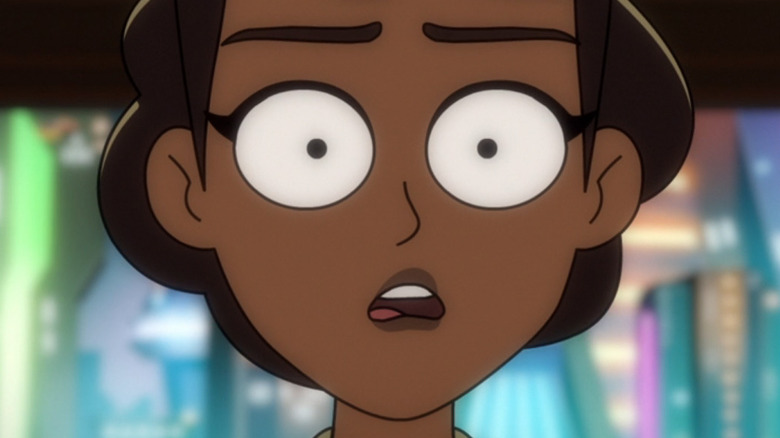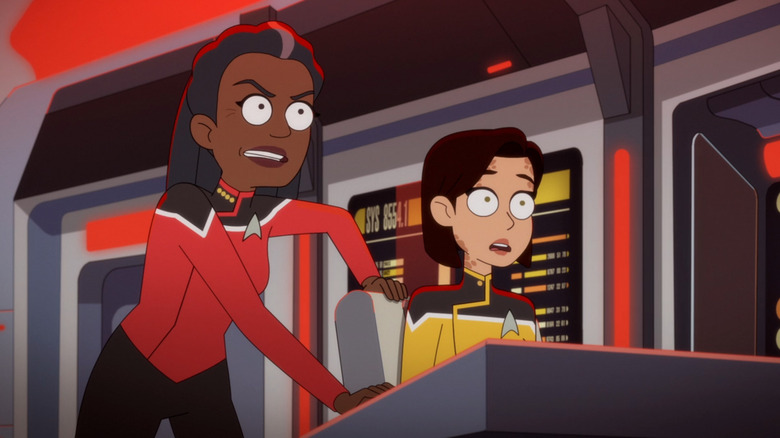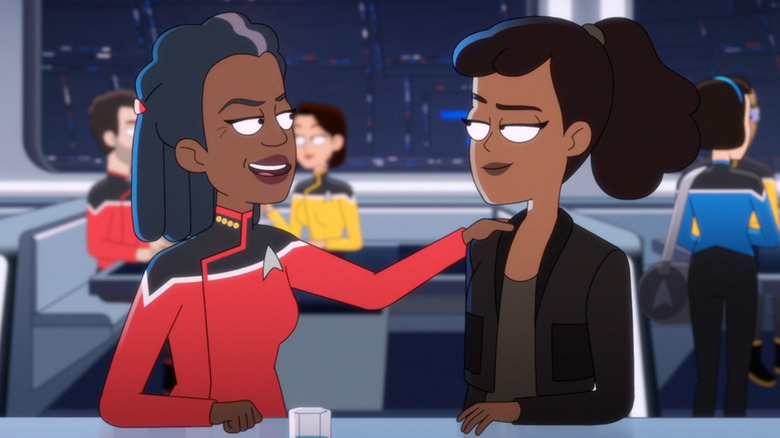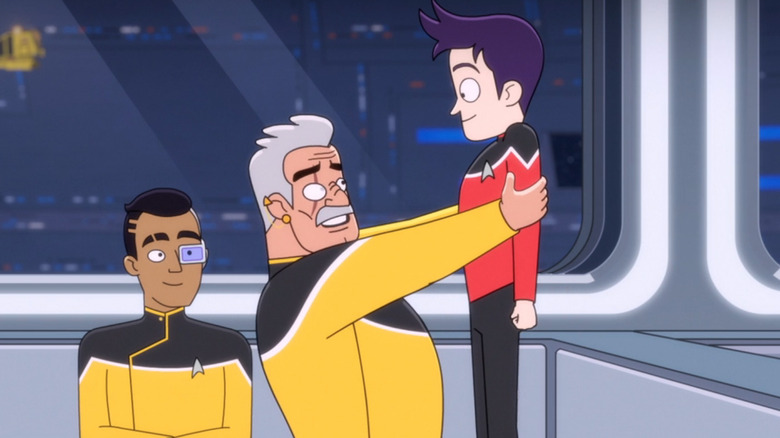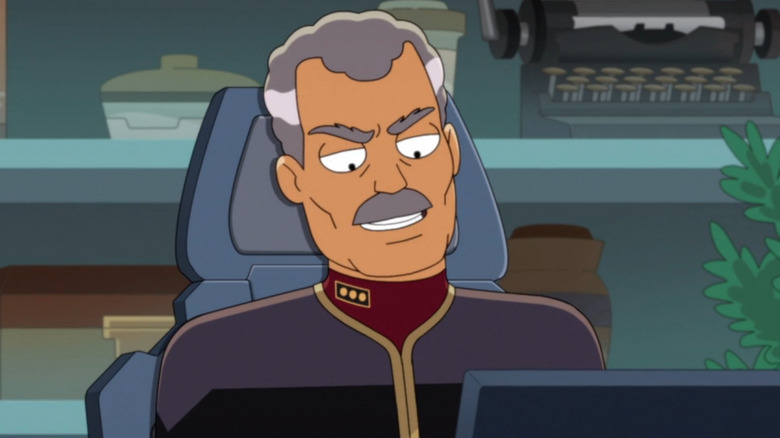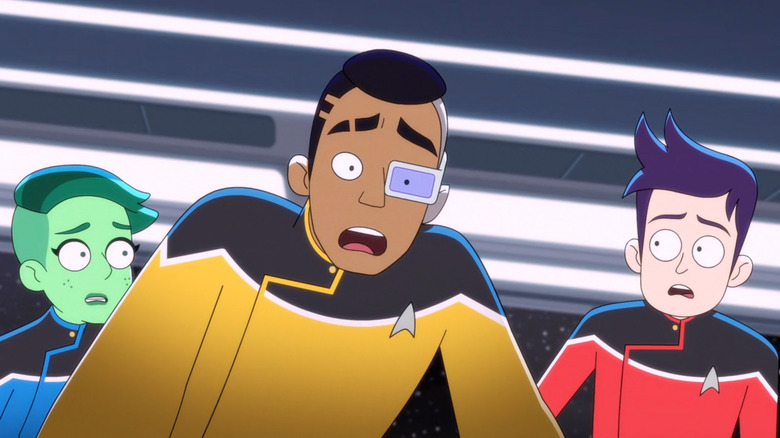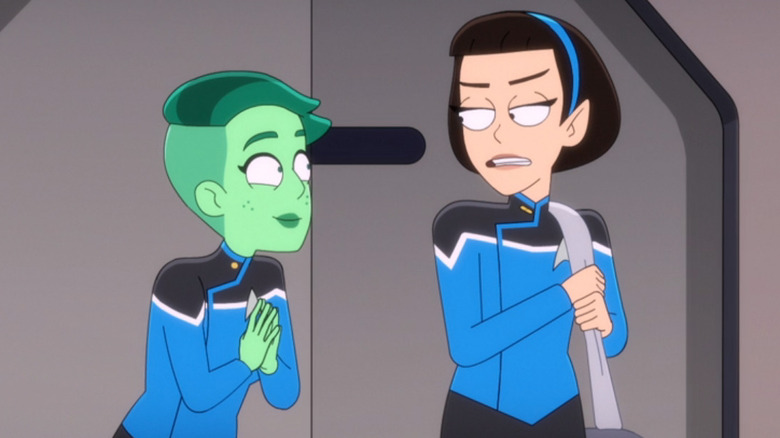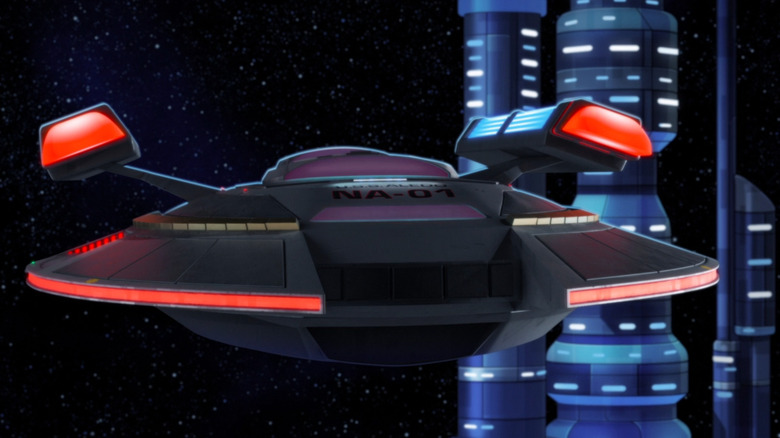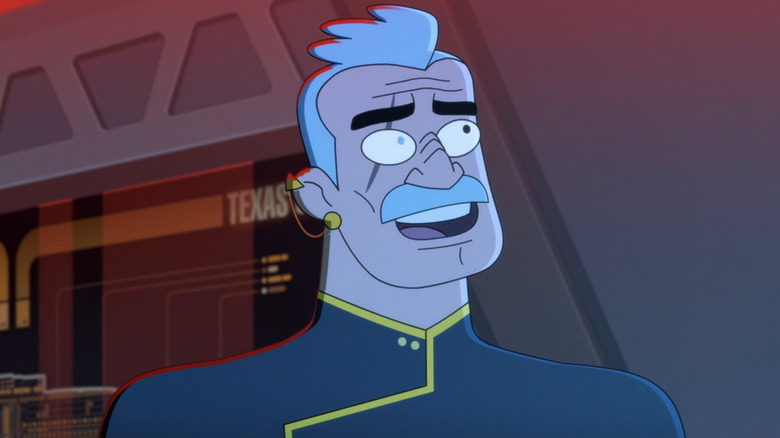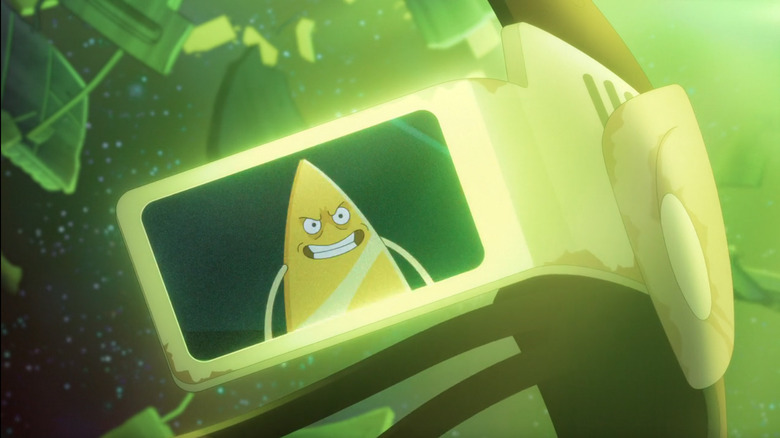The Ending Of Star Trek: Lower Decks Season 3 Explained
Since its launch in 2020, "Star Trek: Lower Decks" has split sides from here to the Gamma Quadrant as the first outright comedy series in the franchise. Focused on a group of young cadets aboard the starship Cerritos, "Lower Decks" has explored the wacky antics and wild misadventures of Orion Ensign Tendi (Noël Wells), purple-haired goofball Ensign Boimler (Jack Quaid), cybernetically enhanced Ensign Rutherford (Eugene Cordero), and the captain's wayward daughter Ensign Mariner (Tawny Newsome). Under the command of Carol Freeman (Dawnn Lewis) — who is joined on the bridge by first officer Ransom (Jerry O'Connell), Lt. Shaxs (Fred Tatasciore), and Dr. T'Ana (Gillian Vigman) — the Cerritos warps around the galaxy performing menial tasks, hoping to find a piece of the bigger action along the way.
Every season of "Lower Decks" has had its own ongoing stories, character arcs, and themes, not to mention events that make important strides forward in "Star Trek" canon. The series has continued to top itself year after year, and Season 3 has been the biggest and boldest yet, with episodes that bring the characters to new and unexpected places. Secrets are revealed, dark truths exposed, and surprising discoveries are made. In the Season 3 finale, "The Stars at Night," every story and character arc from across the season come to a conclusion.
Beyond just wrapping up the season, the finale also ties up several series-long loose ends and answers a few ongoing questions we've had since the very beginning. So raise red alert and send all hands to battle stations, because this is the ending of "Star Trek: Lower Decks" Season 3 explained. Spoilers ahead.
Proving the worth of the California Class
Part of the mission statement of "Star Trek: Lower Decks" as a series was not just to showcase the lower ranked officers aboard a Federation starship, but also the adventures of a lesser Starfleet vessel. While other "Star Trek" shows like "The Next Generation," "Discovery," and "Strange New Worlds" have all featured top-of-the-line Federation starships crewed by the best-of-the-best, "Lower Decks" introduced a more ordinary ship, the California Class USS Cerritos, and its more ordinary crew. For three seasons, Captain Carol Freeman — an otherwise unremarkable Starfleet captain — has led her crew on a quest to demonstrate that the California Class and their crews are every bit as important to the Federation as the Enterprise.
Much of that quest during Season 3 centers on Project Swing By, which saw the Cerritos returning to planets that the Federation hadn't visited in many years to check up on them for potentially problematic updates. Freeman felt these missions could prove the usefulness of the California Class. But in the Season 3 finale, Freeman's plans are threatened by the new unmanned Texas Class starships, who show that they can perform the same missions faster and with fewer resources.
Freeman and the Cerritos show their importance when the Texas Class betrays Starfleet. Assembling a fleet of California Class ships, Freeman leads the attack against a trio of drone starships, finally proving just how good they really are, and why Starfleet can't do without them. Their dedicated crews are more capable than any A.I., and their capabilities are unmatched, too. Heading into Season 4, it seems any doubts about Freeman, the Cerritos, and the California Class have finally been put to rest.
Ensign Mariner's path
Since the beginning of "Star Trek: Lower Decks," Ensign Beckett Mariner has always been the misfit of the group. Not because she's the most bumbling — that would be Boimler — but because she never quite felt like true Starfleet material, despite the fact that she's the daughter of the Cerritos' captain, Carol Freeman. Mariner, a more free-spirited Starfleet officer, is a defiant rule-breaker more often than not. She feels even more alienated in Season 3 when, after her shenanigans in the premiere, her mother assigns her to first officer Ransom, who would work with her to decide whether she's truly a good fit for Starfleet or not.
Though Mariner tried hard, she just couldn't escape feeling stifled by the rigidity and requirements of Starfleet. After meeting a charming rogue adventurer named Petra Aberdeen in "Reflections," Mariner would learn there were other opportunities out there for her. And so, when Captain Freeman believed she'd betrayed the crew of the Cerritos in "Trusted Sources" and had her transferred to Starbase 80, Mariner finally resigned, joining Petra as a free-wheeling relic hunter.
In the Season 3 finale, though, Mariner is shown to still be pining for the Cerritos, and she comes to realize that independence isn't all it is cracked up to be. Returning to save her friends from an attack by the USS Aledo, Mariner finally accepts that her place is in Starfleet and volunteers to be whipped into shape by the reluctant Ransom. A classic "grass is always greener" story, the first bricks on Mariner's path to command have finally been laid.
Bold Boimler
Right out of the gate in Season 3, one of the biggest themes is Ensign Boimler's new stated goal of getting his career on track to command. With high aspirations, Boimler has long been frustrated by his inability to impress his superiors and earn promotions, and he was beside himself when he learned that his former fellow ensign Vendome had recently earned the rank of captain. Feeling like he was not making any progress, Boimler vowed to do things differently: Rather than be cautious and always play it safe, he'd start doing the opposite of his instincts and become... Bold Boimler.
With his new, bolder persona, Boimler took more initiative, accepting missions and assignments he might otherwise have tried to avoid and readily agreeing to any offer that came his way. Sometimes this had tangible rewards, such as in "The Least Dangerous Game," where he gained favor with Shaxs by performing in his choir. Other times it led to precarious situations, such as in "Room for Growth" when he nearly gets himself, Tendi, and Mariner killed by heading into an unmarked area of the ship.
In "The Stars at Night," though, Boimler's initiative and new outspoken attitude are at last rewarded. In the middle of a crisis, he demands that the captain listens to Shaxs' suggestion. When Shaxs' plan works and the day is saved, Boimler earns himself a debt of gratitude from Shaxs, who declares him his bridge buddy and member of the "bear pack." It's a heartwarming moment and one that demonstrates Boimler's growth as a character.
Legacy of the Starfleet Badmiral
Introduced in the Season 3 premiere "Grounded," Vice Admiral Les Buenamigo is an old friend of Captain Freeman's husband Alonzo, close enough to the family that daughter Beckett Mariner sometimes referred to him as "Uncle Les." Throughout the season, Buenamigo is seemingly supportive of Captain Freeman and the Cerritos, assigning them to important missions to help them prove their capabilities and defending them when under scrutiny by Starfleet. But, in the season finale, Buenamigo is revealed to have his own dark agenda as next in a long line of evil admirals — lovingly known as "badmirals" among fans — that have appeared throughout "Star Trek" history.
There had been hints throughout the season that perhaps Buenamigo wasn't truly on Freeman's side, such as when he blindsided her with the reveal of his secret project, the Texas Class starship. Part of a new fleet of unmanned ships, the USS Aledo came to Freeman's rescue when they were attacked by the Breen. When the new ships passed their trial in the encounter, Buenamigo was eager to make this the crowning achievement of his Starfleet career, but the arrival of this new drone fleet would also mean the retirement of the California Class.
As it turns out, the Cerritos' entire journey throughout Season 3 was carefully orchestrated by Buenamigo himself in an attempt to embarrass the captain and her crew. His plan was to force Starfleet's hand in greenlighting his new starship project. Even their mission to Deep Space Nine was designed to fail. But, like all badmirals, his overconfidence is his weakness, and his own A.I. starship turns on him in a moment of sweet irony.
Rutherford's dark origins revealed
One of the biggest storylines running through the first three seasons of "Lower Decks" is the true nature of Ensign Rutherford, the engineer with a cybernetic implant. Right away we know something is up with the young engineer, as his implants frequently and conspicuously malfunction, sometimes leading to a shift in his personality. In Season 2, cryptic flashbacks reveal hints about his origins, confirming that his implants weren't intended to make him a better engineer as he had always believed. In fact, they are part of a sinister conspiracy.
The theme of Rutherford's conflicting identity continues in Season 3, which explores the idea of what makes a person who they are and if it really matters who we once were. In "Reflections," we learn that Rutherford was once a much different engineer, a cavalier risk-taker. However, a catastrophic accident left him injured and in need of the implants that erased his personality. In the Season 3 finale, we discover a dark secret that he himself isn't aware of: He is the designer of the artificial intelligence that powers the experimental, top-secret Texas Class starships. After his accident, Admiral Buenamigo had Rutherford's memories erased to hide his knowledge of the project.
All along, Rutherford has had to consider whether learning the truth would empower him or hurt him. Earlier episodes finally had him accept who he was, and in "The Stars at Night," Rutherford embraces the truth and uses it to do good. His knowledge of the Texas Class' programming helps the Cerritos expose Buenamigo and thwart his diabolical plans. His identity arc comes full circle in the most satisfying of ways.
Tendi's journey
Not to be left out, even Ensign Tendi, the Cerritos' resident Orion junior science officer, gets to fulfill an important character arc in the final episode of "Star Trek: Lower Decks" Season 3. When she first came aboard the Cerritos as a medic, she was eager to prove herself and was obsessed with being the best. She worked hard in her duties and studied harder in her off hours. She was recognized for her efforts by Dr. T'Ana, who transferred her into the science officer training program at the end of Season 2.
Throughout Season 3, Tendi works to rise to her true potential, even learning to embrace her Orion heritage and accept who she is. In her training program she works with Dr. Migleemo, who stresses that being a senior science officer is less about studying data and passing tests and more about being "the voice of science." In the season finale, Tendi takes that advice to heart. While engaged in a race against the Texas Class starship Aledo, the Cerritos visits a supposedly barren world to install a new Starfleet outpost. But Tendi insists they stop to examine a curious reading for evidence of sentient life as part of Starfleet science protocol, rather than simply trying to win the race.
Though it slows their progress and they lose the challenge, her efforts are key to confronting Admiral Buenamigo, whose own ship didn't follow protocol. Meanwhile, Dr. Migleemo praises Tendi for standing up for science, which shows us that sometimes excelling in Starfleet is about more than just memorizing facts and figures.
Evil artificial intelligence
"Star Trek" has a long and complicated history with artificial intelligence. Some of the earliest villains in the franchise were A.I. run amok, such as in the original "Star Trek" series episode "The Changeling" where an artificially intelligent probe called Nomad threatens Kirk and the crew, or in the "Voyager" episode "Prototype" where two races of robotic soldiers are at war and one takes B'Elanna hostage to help them construct more of their own kind. Even in "Lower Decks" plenty of jokes have been mined from the trope, including the introduction of the Self-Aware Megalomaniacal Computer Storage center at the Daystrom Institute housing the likes of Agimus from Season 2, and the sneaky exo-comp Peanut Hamper, as seen just a couple of episodes before the finale.
In "The Stars at Night," it turns out that the programming Rutherford used to design the villainous Badgey in Season 1 was in fact unwittingly derived from the code that his earlier self had used to power the Texas Class drone ships. As Badgey turned out to be malevolent, it stood to reason that the A.I. on the USS Aledo might also be dangerous, and sure enough, that's exactly what happens. This continues the theme of evil A.I. in "Star Trek" and harkens all the way back to the 1968 episode "The Ultimate Computer," in which a sentient new system installed on the Enterprise in an effort to make the crew obsolete goes rogue.
This also reinforces stories from "Star Trek: Picard," "Star Trek: Discovery," and even "Star Trek: The Motion Picture," and it seems to suggest that perhaps artificial intelligence's evolution inexorably slants towards evil.
Shaxs gets his big moment
Lt. Shaxs isn't a "Lower Decker" but a senior bridge officer, the ship's chief of security. As such, he's technically more of a supporting player on the series, but he's no less important in the Season 3 finale. A cantankerous sort, Shaxs can be a rollercoaster of emotion, but in a crisis, he's rock steady. He's also known for his penchant to overreact in critical situations, always suggesting they eject the warp core as a means of saving the day, which has become something of a catch phrase for him. Time after time, Shaxs is shut down by Captain Freeman, who routinely dismisses his over-the-top recommendations.
While Shaxs' tendency to skip right to ejecting the warp core at even the slightest hint of trouble may have been a way of poking fun at Worf on "The Next Generation” (whose aggressive suggestions were repeatedly denied by Captain Picard), he finally gets his moment in "The Stars at Night." When the ship is in danger, being chased by three Texas Class starships, Captain Freeman — at the insistence of Ensign Boimler — finally realizes that Shaxs' suggestion to eject the warp core is just what they need to save the ship.
At the climax of the episode, an elated Shaxs ejects the warp core himself as the crew cheer him on in a moment of validation. The Season 3 finale shows us how Shaxs' more aggressive impulses have their use in the proper place and time, and it's great to see him get his big moment.
The wrath of Badgey?
In a post-credits tag, we see a debris field located in the Kalla system. This seems to be the remnants of the battle that went down there all the way back in the Season 1 finale, "No Small Parts." The battle was fought between the Pakleds and the Cerritos, with Captain Riker and the USS Titan swooping in to save the day at the last moment. Now, more than a year later, we revisit the floating wreckage and close in on what appears to be Ensign Rutherford's original cybernetic implant, which was replaced at the beginning of Season 2.
Just as we can identify the implant, it's struck by a tractor beam and is pulled into an alien vessel that we cannot see. As the tractor beam pulls the implant away, its viewscreen flickers and we see the return of the dreaded Badgey, the villainous holoprogram created by Ensign Rutherford. Originally designed to be part of a training exercise, a malfunction turned Badgey into a murderous psychopath, forcing Rutherford to snap his neck. But when Badgey was reprogrammed, he didn't forget what Rutherford had done to him and conspired to kill his creator.
Though Badgey would fail in this, we thought we'd seen the last of him. With his return in the Season 3 finale, though, it seems "Lower Decks" is setting up a possible Season 4 story arc with Badgey on a blood-soaked quest for vengeance.
